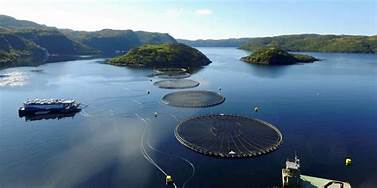In my 30 years in the seafood business, there was nothing more controversial a subject than Farm Raised Salmon. There were customers that had very set views on how they felt about farmed salmon or Aquaculture in general. There are many reasons for what the public believes, and how they feel about it. Also, here in the Pacific Northwest, where wild salmon is a huge industry and important to the economy, and the ecosystem, many strongly feel one way or the other. How aquaculture is important to our ocean stewardship is one issue that we need to consider.

THE LAST WILD FRONTIER
The fishing industry itself is commercially the last wild frontier. People worldwide make their living fishing, and salmon is a big part of the industry. Here in the PNW and Alaska it is not only a major industry but is a huge contributor to the native Americans livelihood. Wild Atlantic salmon fisheries are also popular in Europe, and the north Atlantic. Once upon a time, Atlantic salmon was fished commercially out of the rivers leading to the Great Lakes but was overfished. Commercial and recreational fishing for Atlantic salmon in the United States is prohibited. In addition, the Gulf of Maine distinct population segment (DPS) of Atlantic salmon are protected under the Endangered Species Act.
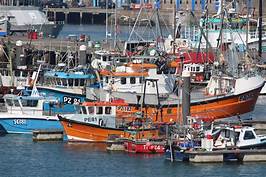
AQUACULTURE IS NOT NEW
Farming in general, is certainly nothing new, it’s been going on somewhere around 12,000 years. Eating farmed cows, pigs, chickens, etc., is the norm. Aquaculture has historically been around for about 4,000 years. China raising carp and many European countries raising oysters, mussels, and some freshwater fish. Tilapia is a fish that has been farmed for over 2000 years and even found in Egyptian tombs. By these standards, farmed salmon is a very new industry. Commercial salmon farming began in the 1970s.
WHY ATLANTIC SALMON?
Salmon Aquaculture being such a new industry has brought with it many challenges. Most commercial fish farms raise Atlantic salmon. Atlantic salmon is a “favored species” to farm in cold marine waters because the species grows quickly and consistently, Unlike the Pacific salmon species, Atlantic salmon do not die after spawning, and adults can repeat the breeding cycle. They live for 4 to 6 years. Farmed Atlantic salmon are more docile than wild fish.

HOW IS SALMON FARMED RAISED?
Farm-raised salmon are grown and harvested in pens either offshore, in the ocean or some are now land based. Farmed salmon is generally raised in two stages, freshwater and saltwater.
- First, the eggs are in hatchery trays until they are ready to hatch.
- After they hatched, they are raised on land in freshwater tanks for 12-18 months, producing smolt (juvenile salmon).
- The smolt are transferred by boat to floating nets or pens in the ocean, where they are fed pellets and grow for another year or two. This is a normal transition for salmon, freshwater to saltwater. A single large sea pen can hold up to 90,000 fish.
- When they reach about 12 lbs, another 1 to 2 years, they are harvested and taken to a processing plant by boat.
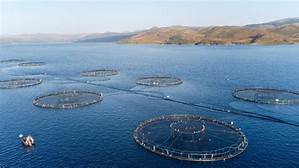
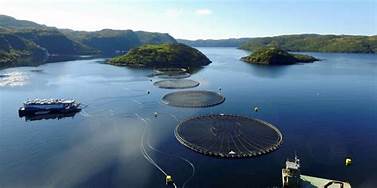

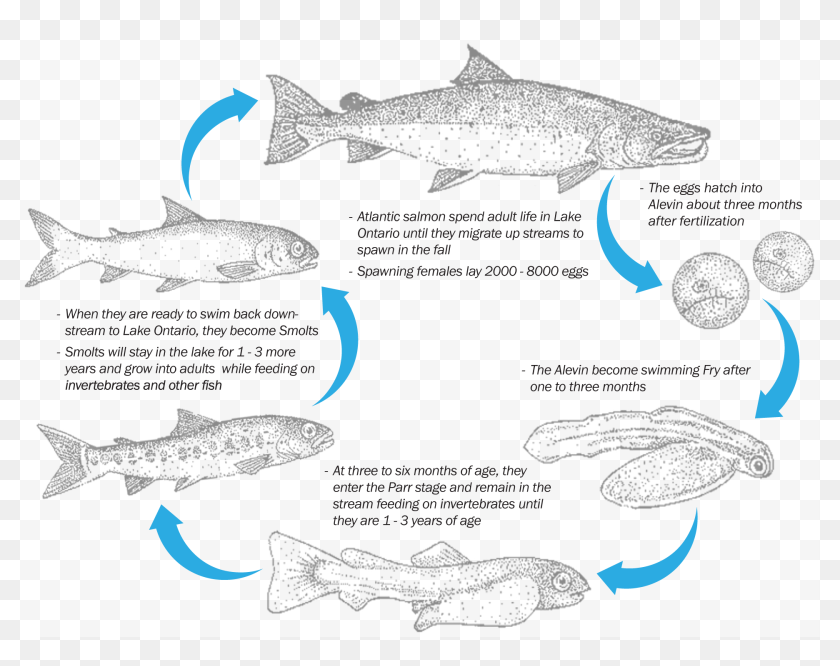
ENVIRONMETAL IMPACT OF SALMON FARMS
Sea lice are parasites on fish and have proved to have significant negative impacts on fish health, particularly in juvenile fish, (adult fish it can be a problem but not detrimental). These lice are not exclusive to farmed fish. It wasn’t uncommon, while working in the seafood department, we would receive a shipment of whole wild salmon that had sea lice attached, usually not more than 2 or 3. The problem with farmed fish in pens, is there are so many in an enclosed pen. It spreads quickly and easily, kind of like when a kid in your own child’s class has lice. Sea lice suck the blood from the salmon causing their immunity to be lowered, therefore making them easily susceptible to disease. If not controlled, an infestation can destroy an entire harvest.
Diseases are often transmitted readily throughout the stock, as a result of the confined conditions that farmed salmon live in. There are many infectious diseases common in salmon. Controlling transmission of diseases on salmon farms through the use medication of the salmon stock has proved somewhat effective. The use of antibiotics has caused some controversy, asking the question is it safe to eat salmon that have been treated with them. However, eradication of infected stocks is still often required.
Release of waste products into the environment, The abundance of salmon in such concentrated areas, primarily open-net cage farms, can result in significant fouling of the ocean floor causing further negative impacts to the environment. the waste products of farmed fish can accumulate under the pens, smothering portions of the ocean bottom, contaminating the marine ecosystem and depriving species of oxygen. The most successful method of prevention in open ocean pens is currently used is about location of the salmon farms, where areas of high currents can disperse and dilute any released waste products, reducing the negative effects on the environment.
Escapees are not uncommon. Farmed salmon individuals escape from sea cages and into the natural environment and when this occurs, it can have negative implications to wild species. The spread of disease to wild stocks is of course a concern, however studies have shown that escaped farmed salmon – in either the Pacific or Northwest Atlantic oceans – have a low survival rate in the wild because they are accustomed to being fed. Further, Atlantic salmon (farmed or wild) cannot successfully mate with wild Pacific salmon
Feed to meat ratio, FIFO, (fish in fish out) was probably my biggest environmental concern with farmed fish. I know in the past the feed ratio was 4 lbs. of wild fish to produce just 1lb of meat from the salmon. Fish meal production has been a significant contributor of over-fishing. There was a significant decline in the food source for almost every predatory fish in its environment, including halibut, rockfish, yellowtail, shark, chinook and coho salmon. The good news is the pellets now used in aquaculture does have a much smaller percentage of fishmeal and includes vegetable proteins. Also, bycatch and fish trimmings from production of whole fish is being used to produce fishmeal. I do have inquiries in to some companies, to find out exactly what is included in the pellets.
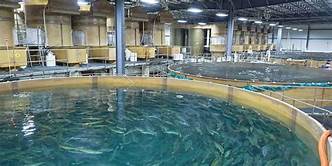
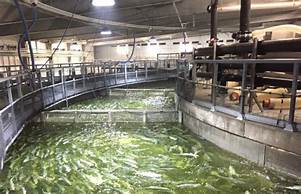
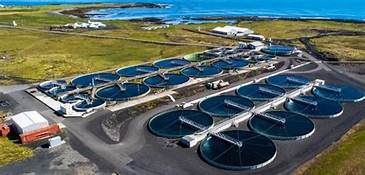
Land based salmon farms offer an alternative to sea-based open net pen farming Land-based salmon farming offers advantages such as proximity to markets, flexible waste management, ideal growing conditions free of disease and pesticide or antibiotic use, and protection for wild populations and marine ecosystems. This is still a work in progress and hopefully will contribute to the sustainability of salmon farming.
Depletion of wild salmon population is a primary concern, and the best reason to support sustainable healthy salmon farms. I had the rare opportunity to go to Alaska a few years back, to Cordova, for the opening day of the Alaska Sockeye season at the mouth of the Copper River. It was an amazing experience to be sure, but sad as well. I was able to be on the docks as the boats brought in their first day catch in, very much below the normal numbers. One of the fishermen told me in his 27 years of fishing the opening day, this was by far the worst. The numbers do fluctuate from year to year, but it is significantly declining.

I recently watched a webinar presentation by the Whale Museum in Friday Harbor, WA. The decline in numbers of their resident killer whales is in big part due to the decline of chinook salmon, the main food source for these whales. Salmon recovery is a huge part of the Orca recovery plan. Humans are not the only creatures of this planet dependent on the sea for sustenance.
Sustainable farmed salmon is an answer to many of these problems.
WILD FISHERIES VS FARMED FISHERIES, A WAR OR A PARTNERSHIP
This time of year, it is not unusual for you to see more than usual bad press about farmed salmon. The wild salmon season is about to begin, May 15. The wild salmon fishermen are concerned about sells of their catch, of course. However, with wild salmon populations down, wouldn’t it make more sense to partner with the farm industry, at least for the foreseeable future, to help bring back the wild salmon. 65% of salmon consumed in the US now is farmed.
Scientist that have studied global population have stated that aquaculture could be the answer to feeding the world. It takes less energy, space and feed to raise fish, crustaceans and mollusks than it does to raise any other animal.
People will always want wild when available, but if we don’t move in a positive direction, using all resources available, there won’t be any wild fish for us or the Orcas.

